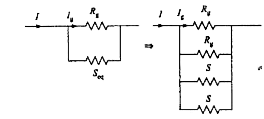Consider two identical galvanometer and two identical resistors with resistance R. If the internal resistance of the galvanometers RC<R2, which of the following statements) about any one of the galvanometers is (are) true?
The maximum voltage range is obtained when all the components are connected in series.
Two maximum voltage range is obtained when the two resistors and one galvanometer are connected in series, and the second galvanometer is connected in parallel to the first galvanometer.
The maximum current range is obtained when all the components are connected in parallel
The maximum current range is obtained when the two galvanometers are connected in series, and the combination is connected in parallel with both the resistors
The correct Answer is:A, C
For maximum voltage vmax=I[Rg+Seq]

for maximum current

here Seq will be parallel combination of two shunt and one galvanometer.
Similar Questions
Consider two identical galvanometers and two identical resistors with resistance R. If the internal resistance of the galvanometers Rc<R/2, which of the following statement(s) about any one of the galvanometers is (are) true?
View SolutionConsider a galvanometer shunted with 5 Ω resistance and 2% of current passes through it. What is the resistance of the given galvanometer ?
View Solution
Knowledge Check
Consider two identical galvanometers and two identical resistors with resistance R. If the internal resistance of the galvanometers Rc<R/2, which of the following statement(s) about any one of the galvanometers is (are) true?
AThe maximum voltage range is obtained when the two resistors and one galvanometer are connected in seriesBThe maximum voltage range is obtained when the two resistors and one galvanometer are connected in series , and the second galvanometer is connected in parallel to the first galvanometerCThe maximum current range is obtained when all the components are connected in parallelDThe maximum current range is obtained when the two galvanometers are connected in series and the combination is connected in parallel with both the resistorsIf G, rA and rV denote the internal resistances of a galvanometer, an ammeter and a voltmeter among the following the correct relationship is
AG<rA<rVBrA<rV<GCrA<G<rVDrV<rA<GIf resistance of voltmeter is 10000Ω and resistance of ammeter is 2Ω then find R when voltmeter reads 12 V and ammeter reads 0.1 A
A118 ΩB120 ΩC124 ΩD114 Ω
Two identical galvanometers are converted into an ammeter and a milliammeter. If the shunt, which has more resistance, the current passing through the coil will be
View SolutionIn a galvanometer there is a deflection of one divisions per mA. The internal resistance of the galvanometer is 80Ω. If a shunt of 2.5Ω is connected to the galvanometer and there are 50 divisions in all, one the scale of the galvanometer, what maximum current can this galvanometer read?
View SolutionIf G,rA and rV denote the internal resistances of a galvanometer, an ammeter and a voltmeter among the following the correct relationship is
View SolutionA sensitive galvanometer ,like a moving coil galvanometer , can be converted into an ammeter or a voltmeter by connecting a proper resistance to it. Which of the following statements is not true ?
View SolutionFor the circuit, the galvanometer G shows zero deflection. If the batteries A and B have negligible internal resistance, the value of the resistor R will be
View Solution
